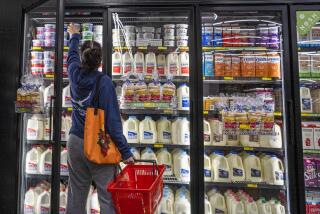July Prices Up Only 0.2% as Economy Cools
- Share via
WASHINGTON — Inflation continued at a moderate pace in July, the government reported Friday, with consumer prices rising only 0.2% for the second month in a row--the best two-month performance since mid-1986.
The recent trend, evident in almost all categories of goods and services except entertainment and medical costs, indicated that the price pressures that sparked fears of renewed inflation earlier this year have abated.
Stacy Kottman, an analyst with the Georgia State University economic forecasting service, said that the recent cooling of the economy--in response to the Federal Reserve Board’s effort beginning last year to increase interest rates--has dampened inflation pressures.
“The whole economy is backing off a bit” from its previous pace, which came dangerously close to causing it to overheat, Kottman said. “We expect continued moderation on the inflation front in the months to come.”
There was no indication of what impact the figures might have on the willingness of the Federal Reserve Board to ease up further on interest rates, which have been falling for two months. The White House has been pushing for such a move, but the Fed has held firm.
The Bush Administration contended that the figures show the overall inflation picture to be improving markedly. In Kennebunkport, Me., where President Bush is on vacation, White House Press Secretary Marlin Fitzwater declared that “inflation is on a downward trend.”
But Joel Popkin, a Washington economist who specializes in inflation, warned that the respite is “nothing more than a summer lull” stemming from an easing of energy and food prices and a rise in the value of the dollar, which reduces the cost of imports.
Popkin noted that prices of services are still rising sharply and predicted that inflation will accelerate again in early autumn, when manufacturers introduce new product lines in everything from apparel to automobiles. “I expect that by fall we’ll be back to a core inflation rate of 5%,” he said.
He speculated also that the Fed may have eased up too early in its moves to avert a recession after raising interest rates last year. It probably succeeded, Popkin said, “but, as a result, it has precluded the opportunity” to drive inflation down.
The price moderation in July was abetted by sharp declines in apparel and transportation prices, reflecting larger-than-usual end-of-season price cuts for women’s clothes and a steep 2.2% falloff in gasoline prices. Prices of new autos and new-car financing also fell markedly.
However, medical prices soared 0.7% in July to a point about 7.5% above their level of a year ago. The index for medical care services rose 0.9% in July, and the cost of medical supplies and pharmaceuticals rose 0.2%.
Entertainment costs also rose sharply during the month, with ticket prices for movies, theaters and musical events jumping 1.3%. The index for other goods and services rose 0.9% in July, after a 0.8% rise in June.
In a separate calculation, the department reported that consumer prices in the Los Angeles-Anaheim-Riverside area rose 0.2% in July, down from a 0.3% rise in June. The indexes for individual cities traditionally are very volatile.
July’s increase brought the national consumer price index to a new level of 124.4% of its 1982-1984 average, meaning that it took $12.44 to buy the same goods and services at retail last month that had cost $10 during the first part of the decade.
During the first seven months of 1989, inflation has advanced at an annual rate of 5.5%--conspicuously high by historical standards. During the year that ended in July, consumer prices rose 5%.
Friday’s report showed that the average weekly earnings of U.S. workers jumped 1.5% in July, after adjusting for inflation and seasonal factors, after a scant 0.1% increase in June. Over the last 12 months, wages--adjusted for inflation--have fallen by 0.9%.
The June-July respite in price increases followed a five-month-long surge in oil and food prices. The spurt ended in late May as oil prices moderated and farm prices slowed down.
But Popkin cautioned that, although the weakening in the economy may help ease inflationary pressures, it will also slow any improvement of productivity, a result that will push labor costs higher and squeeze business profit margins, thus crimping investment.
If that happens, he said, “it could create a recession.”
More to Read
Inside the business of entertainment
The Wide Shot brings you news, analysis and insights on everything from streaming wars to production — and what it all means for the future.
You may occasionally receive promotional content from the Los Angeles Times.









